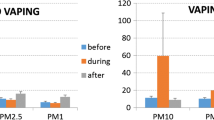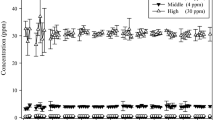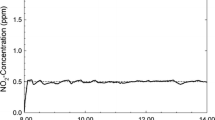Abstract
Inhalation pharmacokinetics of the halogenated ethylenes vinyl fluoride (VF), vinylidene fluoride (VF2), vinyl chloride (VC1), vinylidene chloride (VC12), cis- and trans-dichloroethylene (cis-DCE and trans-DCE), trichloroethylene (Tri), perchloroethylene (Per), and vinyl bromide (VBr) have been comparatively studied in the rat. Rats were exposed in a closed inhalation system to various initial atmospheric levels of halogenated ethylenes, and the decline of atmospheric concentration was followed using gas Chromatographic analysis. From pharmacokinetic analysis of the experimental curves the following general patterns of the halogenated ethylenes were derived.
Distribution of the compounds in the organism and in the gas phase is determined by physical factors. For practical purposes, a relation of the equilibrium constants with the volatilities of the compounds, expressed by the boiling points, may be used: compounds with a low boiling point are enriched in tissues much less than those of a higher boiling point, and vice versa. Compounds with high accumulation in tissues (Tri, Per) need much more time for completion of the equilibration process than more volatile compounds.
Metabolic elimination of halogenated ethylenes is a saturable, dose-dependent process. If animals are exposed to atmospheric concentrations of a halogenated ethylene which exceed the “point of saturation (Sp)”, elimination is determined by a zero-order law, i.e., its rate is independent of the concentration of the compound. In contrast, below saturation normal first-order kinetics apply.
If the rate of metabolic elimination is related to the concentrations of the compounds in the tissue compartment, very similar rates for first-order elimination of the different halogenated ethylenes are found. This suggests a common rate limiting factor applicable for the lower concentration range.
The maximal velocities (V max) of metabolic elimination of halogenated ethylenes which are reached above the “saturation points” depend on the chemical structures of the individual compounds. In general, with the exception of Tri, further halogen substitution inhibits metabolic conversion. Of the halogenated ethylenes, VF2 and Per are extremely slowly metabolized.
The present report also provides the data necessary for calculation of the rates of metabolism of halogenated ethylenes in rats at a given concentration of atmospheric exposure.
Similar content being viewed by others
References
Bolt, H. M.: Pharmacokinetics of vinyl chloride. Gen. Pharmacol. 9, 91–95 (1978)
Bolt, H. M., Kappus, H., Buchter, A., Bolt, W.: Disposition of 1,2-14C-vinyl chloride in the rat. Arch. Toxicol. (Berl.) 35, 153–162 (1976)
Bolt, H. M., Laib, R. J., Kappus, H., Buchter, A.: Pharmacokinetics of vinyl chloride in the rat. Toxicology 7, 179–188 (1977)
Bolt, H. M., Buchter, A., Wolowski, L., Gil, D. L., Bolt, W.: Incubation of 14C-trichloroethylene vapor with rat liver microsomes: uptake of radioactivity and covalent protein binding of metabolites. Int. Arch. Occup. Environ. Health 39, 103–111 (1977a)
Bolt, H. M., Filser, J. G., Hinderer, R. K.: Rat liver microsomal uptake and irreversible protein binding of 1,2-14C-vinyl bromide. Toxicol. Appl. Pharmacol. 44, 481–489 (1978)
Bonse, G., Henschler, D.: Chemical reactivity, biotransformation, and toxicity of polychlorinated aliphatic compounds. CRC Crit. Rev. Toxicol. 5, 395–409 (1976)
Bonse, G., Urban, Th., Reichert, D., Henschler, D.: Chemical reactivity, metabolic oxirane formation and biological reactivity of chlorinated ethylenes in the isolated perfused rat liver preparation. Biochem. Pharmacol. 24, 1829–1934 (1975)
Buchter, A., Bolt, H. M., Filser, J. G., Goergens, H. W., Laib, R. J., Bolt, W.: Pharmakokinetik und Karzinogenese von Vinylchlorid; Arbeitsmedizinische Risikobeurteilung. Verh. Dtsch. Ges. Arbeitsmedizin (A. W. Gentner Verlag, Stuttgart) 18, 111–124 (1978)
Gehring, P. J., Watanabe, P. G., Young, J. D.: The relevance of dose-dependent pharmacokinetics in the assessment of carcinogenic hazard of chemicals. In: Origins of Human Cancer (H. H. Hiatt, J. D. Watson, J. A. Winsten, eds.), pp. 187–203. Cold Spring Harbor Conferences on Cell Proliferation, Vol. 4. Cold Spring Harbor Laboratory 1977
Gehring, P. J., Watanabe, P. G., Park, C. N.: Resolution of dose-response toxicity data for chemicals requiring metabolic activation: example vinyl chloride. Toxicol. Appl. Pharmacol. 44, 581–591 (1978)
Kappus, H., Bolt, H. M., Buchter, A., Bolt, W.: Liver microsomal uptake and transformation to protein alkylating metabolites in vitro. Toxicol. Appl. Pharmacol. 37, 461–471 (1976)
McKenna, M. J., Zempel, J. A., Madrid, E. O., Braun, W. H., Gehring, P. J.: Metabolism and pharmacokinetic profile of vinylidene chloride in rats following oral administration. Toxicol. Appl. Pharmacol. 45, 821–835 (1978)
Reichert, D., Henschler, D.: Uptake and hepatotoxicity of 1,1,-dichloroethylene by the isolated blood-perfused rat liver. Int. Arch. Occup. Environ. Health 41, 169–178 (1978)
Author information
Authors and Affiliations
Rights and permissions
About this article
Cite this article
Filser, J.G., Bolt, H.M. Pharmacokinetics of halogenated ethylenes in rats. Arch Toxicol 42, 123–136 (1978). https://doi.org/10.1007/BF00316492
Received:
Issue Date:
DOI: https://doi.org/10.1007/BF00316492




